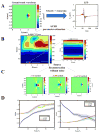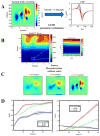waveCSD: A method for estimating transmembrane currents originated from propagating neuronal activity in the neocortex: Application to study cortical spreading depression
- PMID: 29997062
- PMCID: PMC6086575
- DOI: 10.1016/j.jneumeth.2018.06.024
waveCSD: A method for estimating transmembrane currents originated from propagating neuronal activity in the neocortex: Application to study cortical spreading depression
Abstract
Background: Recent years have witnessed an upsurge in the development of methods for estimating current source densities (CSDs) in the neocortical tissue from their recorded local field potential (LFP) reflections using microelectrode arrays. Among these, methods utilizing linear arrays work under the assumption that CSDs vary as a function of cortical depth; whereas they are constant in the tangential direction, infinitely or in a confined cylinder. This assumption is violated in the analysis of neuronal activity propagating along the neocortical sheet, e.g. propagation of alpha waves or cortical spreading depression.
New method: Here, we developed a novel mathematical method (waveCSD) for CSD analysis of LFPs associated with a planar wave of neocortical neuronal activity propagating at a constant velocity towards a linear probe.
Results: Results show that the algorithm is robust to the presence of noise in LFP data and uncertainties in knowledge of propagation velocity. Also, results show high level of accuracy of the method in a wide range of electrode resolutions. Using in vivo experimental recordings from the rat neocortex, we employed waveCSD to characterize transmembrane currents associated with cortical spreading depressions.
Comparison with existing method(s): Simulation results indicate that waveCSD has a significantly higher reconstruction accuracy compared to the widely-used inverse CSD method (iCSD), and the regularized kernel CSD method (kCSD), in the analysis of CSDs originating from propagating neuronal activity.
Conclusions: The waveCSD method provides a theoretical platform for estimation of transmembrane currents from their LFPs in experimental paradigms involving wave propagation.
Keywords: Cortical spreading depression; Current source density analysis; Local field potential; Wave propagation.
Published by Elsevier B.V.
Figures












References
-
- Aroniadou VA, Keller A. The patterns and synaptic properties of horizontal intracortical connections in the rat motor cortex. Journal of neurophysiology. 1993;70:1553–69. - PubMed
-
- Barth DS, Baumgartner C, Di S. Laminar interactions in rat motor cortex during cyclical excitability changes of the penicillin focus. Brain research. 1990;508:105–17. - PubMed
-
- Box GE, Cox DR. An analysis of transformations. Journal of the Royal Statistical Society. Series B (Methodological) 1964:211–52.
Publication types
MeSH terms
Grants and funding
LinkOut - more resources
Full Text Sources
Other Literature Sources

